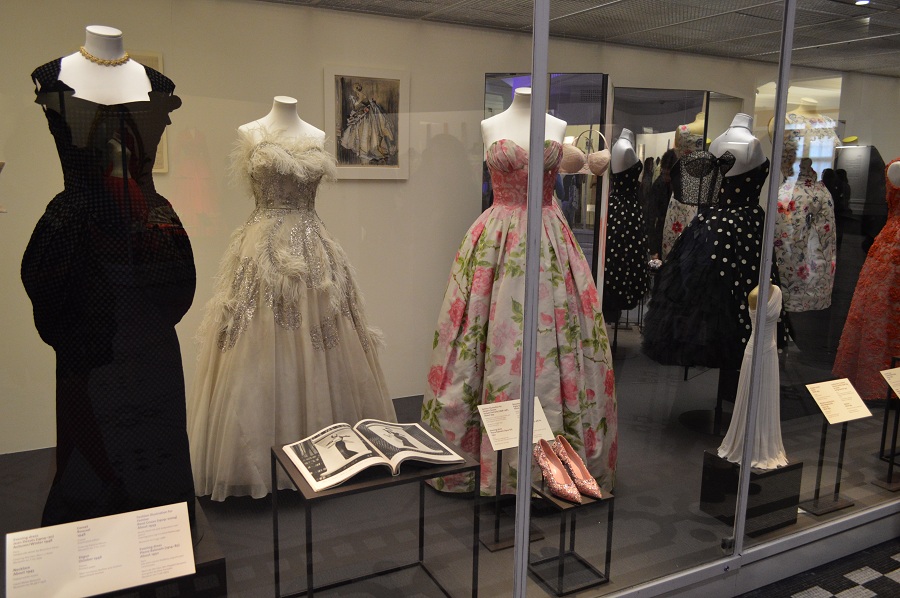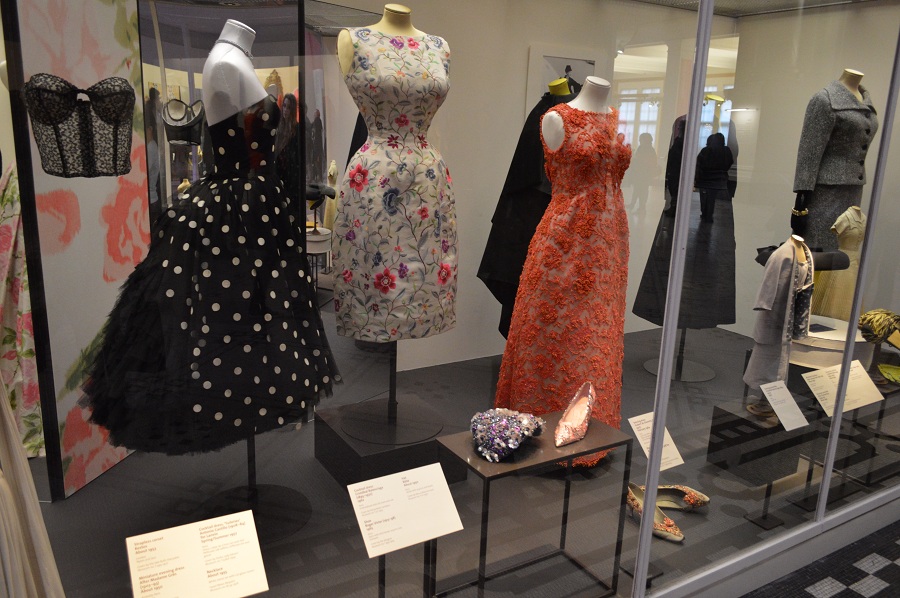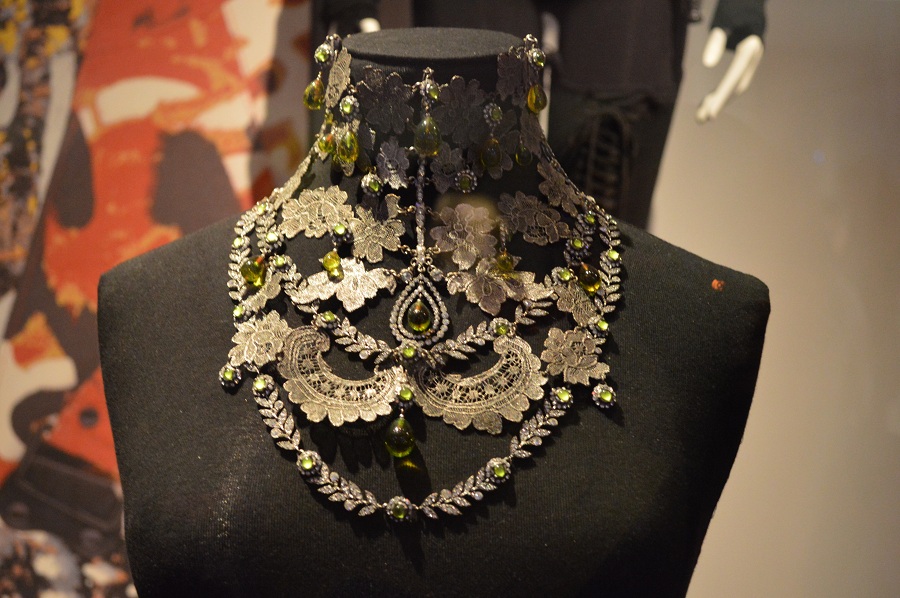![]() Vizitand muzeul Victoria & Albert in Londra, am fost placut surprinsa de galeriile de moda europeana unde am vazut modele, materiale si accesorii din 1750 pana in present. Va prezint astazi jumatatea mai recenta (din 1920 pana in present), urmand sa revin cu inca o intoarcere in trecut intr-un articol separat pentru a va arata cealalta jumatate. Mi-a placut mult incursiunea in lumea modei si chiar m-a motivat sa invat mai multe, cumparand doua carti de la libraria muzeului. Va las sa descoperiti mai jos ce am vazut (descrierile diferitelor perioade insotesc creatiile de mai jos si apartin muzeului).
Vizitand muzeul Victoria & Albert in Londra, am fost placut surprinsa de galeriile de moda europeana unde am vazut modele, materiale si accesorii din 1750 pana in present. Va prezint astazi jumatatea mai recenta (din 1920 pana in present), urmand sa revin cu inca o intoarcere in trecut intr-un articol separat pentru a va arata cealalta jumatate. Mi-a placut mult incursiunea in lumea modei si chiar m-a motivat sa invat mai multe, cumparand doua carti de la libraria muzeului. Va las sa descoperiti mai jos ce am vazut (descrierile diferitelor perioade insotesc creatiile de mai jos si apartin muzeului).
![]() Visiting Victoria & Albert Museum in London, I was pleased to see European fashion galleries with fabrics and accessories from 1750 till present. Today I reveal the first half (since 1920 till present) and I promise to come back in order to show you the other half. I loved the fashion journey and I felt motivated to learn more. I bought two books related to fashion history from the museum books store. You can discover below what I saw (the descriptions are related to the photos below and belong to the museum).
Visiting Victoria & Albert Museum in London, I was pleased to see European fashion galleries with fabrics and accessories from 1750 till present. Today I reveal the first half (since 1920 till present) and I promise to come back in order to show you the other half. I loved the fashion journey and I felt motivated to learn more. I bought two books related to fashion history from the museum books store. You can discover below what I saw (the descriptions are related to the photos below and belong to the museum).
Bright Young Things (1920 -1930)
Fashion in the 1920s was dominated by the garconne look. Simple, straight and waistless, the style was modern and liberating. Delicate silk and chiffon became popular for underwear, while girdles and bandeaux bras were worn to smooth the figure into the desired body shape. Hair was cropped short and close-fitting cloche hats became popular.
For dance crazes like the Charleston, couture houses such as Callot Soeurs and Voisin created evening dresses in lightweight fabrics, worn with strings of beads made from new plastics. As skirts became shorter, shoes became focal point. Silver and gold glace kid was popular for the evening.
The fashion for rich and sensuous detail continued with fringed shawls, dresses embroidered in the Chinese style and evening coats trimmed with fur. The excavation of Tutankhamen’s tomb in 1922 inspired a wave of Egyptian-inspired fashions, with ostrich feather fans and accessories adorned with hieroglyphs.
The Modern Woman (1925 -1940)
The 1920s and ‘30s saw a new freedom for women in dressing for sport and leisure. Many designers introduced ‘resort’ collections for the smart set, using innovative fabrics such as jersey. Coco Chanel championed the trouser suit and even created a de luxe evening version in shimmering sequins.
Designers such as Elsa Schiaparelli challenged the grand couture houses of Paris with her dramatic and witty collections. She made a virtue out of new zip fastening and introduced a range of perfumes. Other designers also created perfumes to help market their brand.
The fashionable gamine look of the 1920s matured into the sophisticated glamour of Art Deco with clinging full-length dresses cut on the bias for a closer fit. The gleaming satins and silks were reflected in polished metal clutch bags and modern aluminum and mirrored furniture. Hollywood film stars such as Marlene Dietrich perpetuated the siren look.
Tailored to Fit (1940 -1960)
Before the Second World War, bespoke fashion in London was mainly the work of tailors and court dressmakers. The Incorporated Society of London Fashion Designers was formed in 1942. Most of its members were based in Mayfair and savile Row. They became known for their practical, beautifully made tailoring using the finest tweeds and woolen fabrics from Scotland.
During the war the Board of Trade commissioned INCSOC to design a Utility collection. A selection was mass produced following the strict clothing regulations. Skirts were limited to knee length, no pleats or folds were allowed and jackets could only have three buttons. In the late 1940s the square-shouldered, masculine fashions of the war changed in response to Paris trends. London couturiers favored two silhouettes: the first narrow waisted and full skirted in line with Christian Dior’s New Look, the second with elegant, streamlined profile that foreshadowed the clean lines of the 1960s.
Revolution (1960 – 1970)
A new generation of designers brought fresh ideas to the making and selling of clothes. Mary Quant and her contemporaries successfully challenged the dominance of Paris fashion. They opened boutiques selling affordable, youthful fashions. Their creations became successful exports epitomizing ‘Swinging London’
Many manufacturers and designers experimented with new materials like plastic and paper to create disposable fashions. At the same time, Paris designers such as Andre Courreges produced luxury ready-to-wear clothes for the younger market and pushed traditional couture techniques to create clothes for the Space Age.
Italian fashion began to emerge after the war, with designers like Emilio Pucci providing sophisticated clothes for the jet set. Pucci became one of the first designers to use a signature style for high-status fashion licensing. His printed silks for both women and men vividly express the psychedelic mood of the late 1960s and early ‘70s.
Deconstructing Fashion (1975 -1985)
During the late ‘70s, Vivienne Westwood and Malcolm McLaren’s shop in King’s Road was at the centre of London’s emerging punk movement. Closely associated with bands such as the Sex Pistols, punk was anti-establishment, androgynous and improvised. Its influence is still felt today in graphics, music and fashion.
By the early 1980s Westwood was drawing on ethnic and historical influences, with collections such as pirate and Buffalo. The British designer John Galliano graduated in 1984 from Central St Martins. His collection, Les Incroyables, was inspired by the French Revolution and later he went on to design for Givenchy and Dior.
In the same decade the Japanese designers Yohji Yamamoto and Rei Kawakubo (designing under the name Comme des Garcons) began to show in Paris. Their work challenged conceptions of the fashionable body, with over-sized and asymmetrical designs, often in black. It caused outrage, but as Kawakubo said, ‘playing it safe is a risky business’.
Radical Fashion (1990 -2012)
Menswear collections shown in Milan and Paris have become an increasingly important event in the fashion calendar. In the ‘90s collector Mark Reed bought many of the flamboyant looks offered by designers such as Jean-Paul Gautier. Wearing them to London art openings, he said, ‘I think people have forgotten how to dress’.
By the mid-1990s ‘stealth luxury’ was an increasingly dominant trend, as the fashion cognoscenti began to reject overt labeling and logos in favor of functional essence. The pared-down minimalism of Calvin Klein, Helmut Lang and, later Nicolas Ghesquiere for Balenciaga relied on a perfect, honed physique.
The internet has had a powerful impact on fashion, from global forecasting websites to individual blogs. On-line fashion magazines and e-tailing offer new opportunities for the consumer. While top fashion houses still exert their influence through catwalk collections, ‘designers for the high street’ provide instant, on-trend fashion for everyone.











Fata lu’ Nona esti! 🙂 Hihi foarte multe informatii interesante, imi plac mult modelele din poza a doua! 😀
Awesome website you have here but I was curious about if you knew
of any user discussion forums that cover the same topics talked about in this article?
I’d really like to be a part of online community where I can get comments from other knowledgeable people that share the same interest.
If you have any suggestions, please let me know. Thanks!